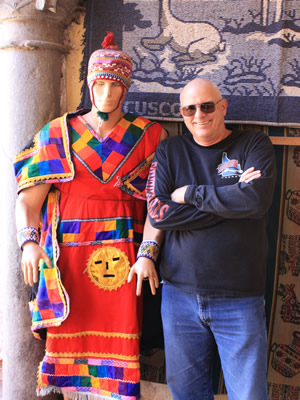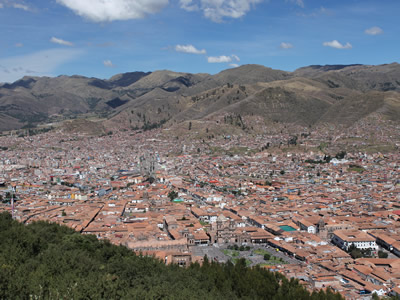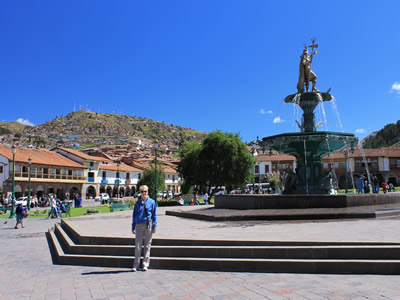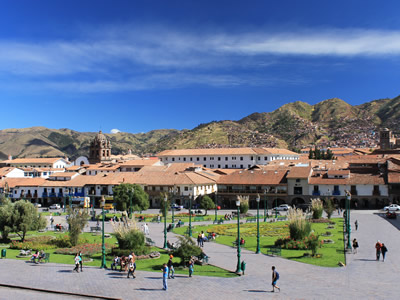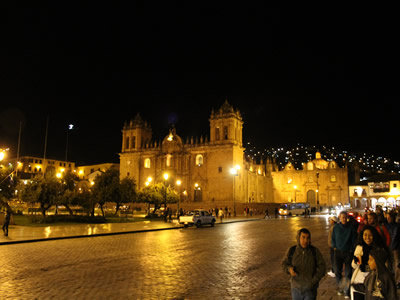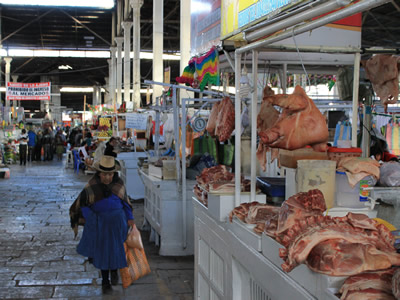Peru - Cusco
Cusco was the Inca capital before their conquest by the Spanish. It was originally built in about 900 CE by the Killke culture. The Incas arrived in Cusco in about 1200 CE and shared the area with the Killke for over a hundred years. It was the ninth Inca, Pachacuti, who took total control of Cusco, and created the Inca Empire. Under his rule the Incas conquered many neighboring people and started a century of expansion until they controled most of modern day Peru, Equador and Bolivia. In Quechua, the Inca Empire was known as Tawantinsuyu.
It didn't last very long. In 1532, Francisco Pizarro arrived in Peru at the head of an expedition to conquer the Incas. Although Pizarro led only 168 Spanish soldiers to invade an empire with a population of millions of people, he had several important things in his favor. When the Inca Huayna Capac had died in 1528, a bloody civil war broke out between his two sons, Huascar and Atahualpa, which was tearing the empire apart. At the same time, an epidemic of small pox had spread to Peru from the Spanish in Central America and was adding to the decimation of the empire. Finally, many of the people who had been conquered and oppressed by the Incas quickly joined forces with the Spanish to throw off Inca rule. Add to that the psychological impact of the Spaniards superior technology: horses, full-body armor and firearms, which the Incas thought were magic, and Pizzaro accomplished what seemed impossible. The Incas were deposed and had to flee. Although they held out and fought a guerilla-style war, the last Inca emperor was finally executed in 1572.
Pizarro conquered Cusco in 1533. In 1535 he founded the city of Lima and made it his capital, replacing Cusco. He wanted a city on the coast rather than in the mountains, and he wanted to diminish the importance of Cusco with its traditions as the Inca capital.
Today Cusco is a city of half a million people. It is a UNESCO World Heritage site. It has beautiful architecture, with many buildings retaining walls and foundations dating back to Inca times. There are also many beautiful Spanish colonial buildings, some of them five hundred years old.
The people of Cusco are primarily indigenous, the descendents of the ancient Incas. Quechua, the language of the ancient Incas, is still spoken by many people at home, although Spanish is common as well. Since the 1970's, tourism has been growing in Cusco and today it is the center for tourism in Peru. It has beautiful buildings, shops, restaurants, and is the gateway for the thousands of tourists who visit Machu Picchu. Most do it as a long day trip by train from Cusco (it's four hours each way) although the crazy few, like us, trek the Inca Trail or other routes and can take a week or more to reach Machu Pichhu by trail.
We had three days and nights in Cusco before our trek. Since the city is at 11,200 feet it would give us time to acclimatize to altitude before our trek. That is really high for a major city. By comparison, the highest town that I am familiar with in the US is Leadville, Colorado, which is only 10,000 feet high. So our time there would be important to give our bodies time to make important adjustments to the thin air in the Andes.
We did have to chuckle the second day that we were in Cusco when we saw a group of visitors in the lobby with an oxygen tank that they were passing around. Yes, Cusco is high but if you can't even sit on a comfortable chair in the hotel lobby sipping tea without using supplementary oxygen then you should probably stay home. Although our room was on the third floor we made a point of always using the stairs. I think we were the only guests in the whole place who didn't use the elevators.
Our hotel had an excellent location. It was at most a ten minute walk to the Plaza de Armas, the center of all activity in Cusco. This square was the heart of the Inca capital. During the fifteenth century it was twice as large as it is currently. The residence of the Sapa Inca was on this square along with several important temples. When Pizarro conquered Cusco in 1532 he made his proclamation here. Tupac Amaru II, considered the last Inca ruler, led an unsuccessful uprising against the Spanish and was executed in the Plaza de Armas in 1781. Today two of the most important buildings in Cusco face this square. The Cathedral, built in 1539, and the Iglesia de la Compania de Jesus (Church of the Society of Jesus), which was built in 1576. For many years there was a competition between the two churches to see which could be grander. Eventually the church built by the Jesuits won, but the resentment caused them to be censured by the King of Spain for building a church that surpassed the official cathedral. I went to a Jesuit high school - sounds just like the Jebs to me.
Besides the churches the plaza was lined with shops and restaurants. There was even a Starbucks, a KFC and a McDonalds's on the plaza, but they were very low key. We actually went past the McDonald's twice without noticing it. The third time we actually looked hard, since we had read that there was one on the plaze, and were able to find it. I thought that was pretty cool, that they could be there without disrupting the atmosphere of the plaza and the city.
After the Plaza de Armas we walked to the San Pedro Public Market, which was about a half a mile away. This place was a zoo. It was just incredible. About half of the market was devoted to locals. There were vegetables, meats, fruits, and every other conceivable thing for sale. A walk through the meat market was interesting - it was enough to make almost anyone consider becoming a vegetarian. All you right wingers who want to shut down the government should walk through the Cusco meat market. Public health laws are a very good thing.
The other part of the market was devoted to tourist things. And they had lots of good stuff. Over our three days in Cusco we made several trips to the market. There was a lot of knitted stuff. Sandy could buy nice sweaters for $10-15 US. That's the price of a tshirt. So when Sandy would ask which one of two sweaters she should get, I would just say that she should buy them both. There were also good deals on wool hats. We got our Peru official head gear for the trek. We also bought nice wool mittens. There were tshirts (yes, I bought several). Belts. Baseball caps. Jewelry. There was just tons of stuff and all of it was a good deal. By the time our three days in Cusco were over and we were packing for the trek, we found out that we had way too much stuff to fit in the one suitcase that we were going to leave in the hotel in Cusco. I had to make an emergency trip out at 9pm our last night in Cusco to buy an extra bag for all the stuff we wanted to store at the hotel.
